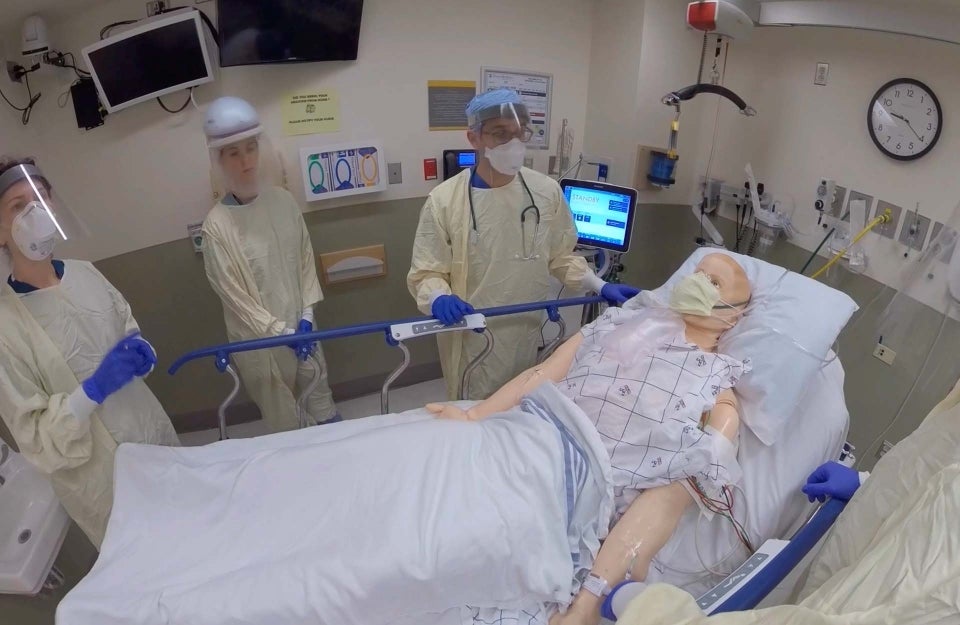Videos, Webinars and Lots of Feedback: Medical Training’s Shift Amid COVID-19
A new virtual reality training video helps doctors learn how to treat COVID-19 patients.

A still from a COVID-response training video, filmed in full 360-degree virtual reality.
Blinking and rasping, the patient admits that it’s hard for him to breathe. He is suspected to have COVID-19 and he needs to be intubated. It’s a routine procedure that has taken on added risk because it so easily “aerosolizes” the germs that cause the disease, sending them widely into the air.
Throughout the procedure, Lauren Weinberger Conlon, MD, the director of the Emergency Medicine residency program at the Hospital of the University of Pennsylvania (HUP) is the quarterback, donned in extensive personal protective equipment (PPE) and calling out steps and gently reminding her team of similarly clad medical residents of best practices. They all talk to each other, confirming everything as they do it. It doesn’t take long for the patient to be fully intubated, now receiving oxygen much more easily and that much closer to recovery from a virus that has swept across the world.
“Great job, guys,” Conlon says.
Then the video goes to black.
Throughout, as Conlon and the team spoke, text appeared on the screen, providing clear directions and extra insight for what the viewer is already seeing and hearing. A 360-degree video, which can be manipulated on an ordinary computer by using a mouse or with a virtual reality headset by moving your head, allows those watching to virtually turn the camera and observe different aspects of the action.
There’s an adage in medical residency training for learning how to do procedures: “See one, do one, teach one.” In the COVID-19 era, “see one” is increasingly looking like this: training videos. Additionally, there are also online conferences to impart best practices on how to operate in a substantially different medical environment that discourages some of the typical hands-on learning in order to prioritize the safety of doctors in training.
It’s important to make sure everyone who doesn’t need to be in a room is cleared out, and that everyone involved has talked through and prepared with the necessary PPE, noted Dane Scantling, DO, a trauma/critical care fellow at Penn Medicine who was on a COVID unit in April.
As a result, only the most experienced residents perform intubations of COVID-positive patients. One of those who have is third-year Emergency Medicine resident Umang Jain, MD. COVID-19 patients are typically harder to intubate because of the inflammation the virus causes, and some of the PPE, such as a PAPR (Powered Air-Purifying Respirators) requires special training, so Jain said younger residents don’t perform the procedure.
As such, keeping staff trained and informed during the pandemic has posed an ongoing challenge.
“We have daily meetings with our chief, running through a list of topics on COVID-19,” Scantling said. “It’s been a lot of coordinating and battle planning. It’s a new and different experience from what was planned for my fellowship.”
Message Board
Because hands-on learning and in-person simulations have been so altered during the pandemic, there is now high demand for updated training videos, not just for early-career doctors, called interns and residents, but for seasoned doctors now encountering a totally new disease in COVID-19.
Such was the case for the 360-degree intubation video. In early April Kyle Cassidy, a digital design specialist at the Annenberg School for Communication at Penn, saw a post on a message board for the Society for Simulation in Health Care asking for virtual resources to help train ICU staff. Just before the outbreak, he’d checked out a pair of virtual reality cameras from the Penn Libraries. They were sitting in his living room, so volunteered to help. Quickly, Kevin Ching, MD, an assistant professor of clinical emergency medicine and of pediatrics at Weill Cornell Medicine in New York City, responded.
“He expressed the urgency for getting information to doctors as quickly as possible,” Cassidy said. “Though we’ve never actually met, we’ve had a lot of Zoom meetings and I’ve spent more face-to-face time with him in the past month or so than anybody I actually work with.”
They worked quickly to get the video filmed at HUP with real Penn Medicine staff — including third-year resident Jain as a star, along with Conlon and Julie Kurkowski MSN, RN, a lead simulation nurse at HUP’s Emergency Department. They also got help from Ann Hoyt Brennan, MSN, RN, the director of the Helene Fuld Pavilion for Innovative Learning and Simulation at Penn Nursing, to get nurses to play roles in the video, and from Neel Naik, MD, and Amos Shemesh, MD, both in the Department of Emergency Medicine at Weill Cornell Medicine, to plan the video further. Next, it was edited by Christopher Vandegrift from the Penn Libraries. Then it was posted to YouTube and shared on physician message boards.
“The COVID-19 crisis is forcing front-line health care providers across the U.S. and world — many with limited experience in emergency settings — to quickly adapt,” Ching explained. “This is an evolving situation, and the medical literature on how to approach resuscitation in a COVID patient is limited, so we drew from the experiences of emergency providers working with the most critically ill COVID-19 patients in New York and Philadelphia.”
In just 24 hours, the video amassed more than 2,000 views. Comments left by doctors in a survey posted with the video explained that they felt much more prepared after studying the video.
Moving forward, Cassidy and Ching are talking about doing more videos, perhaps centered on COVID-19 patients who might be pregnant or are suffering from cardiac arrest.
A Changed Environment for Clinical Training
Even though safety protocols may change which doctors in training perform procedures on certain patients or are even in the room, Jain believes they are still finding opportunities for safe and appropriate training because of hospital patients without the virus.
“There are still the people having flare-ups of asthma and COPD that need attention and intubation. You can’t forget about them,” Jain said. “So I think residents will be very well trained.”
Since COVID-19 is so new, there really aren’t that many established best practices to hand down, but the environment of a teaching hospital offers continuous learning — both from colleagues and from online resources.
“We had our own fantastic ER and ICU nurses come down to train in-person for how to use PPE,” Jain said. “They were able to give us feedback right there on how we can better protect ourselves and our patients: ‘This is how you take off your gown, wash your hands, then go into rooms again.’”
Additionally, his team had webinars with doctors from hard-hit areas like Seattle and New York. Scantling said a Penn alum in Italy did one with his department. In each, the doctors explained what has been learned from their corners of the outbreak to help build a more thorough base of knowledge about the new virus.
Conlon said she is used to direct engagement with her residents, so it’s been a bit of an adjustment for her to have residents rely more heavily on video training. But even through that, she’s making sure everyone gets more substantive, immediate feedback on their work.
“I don’t know if we have the answer for the best way to train now,” Conlon said. “I think that we’re realizing that we’re going to have to start training in ways that we haven’t in the past to keep everyone, the doctors, nurses, staff, and patients, safe.”



